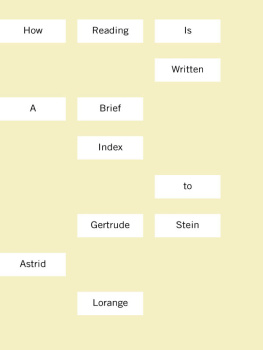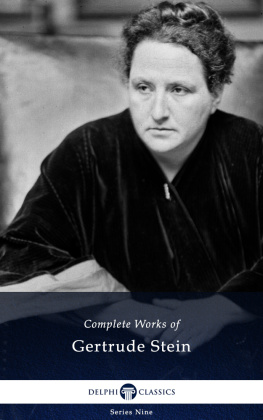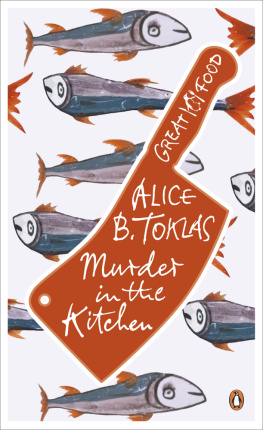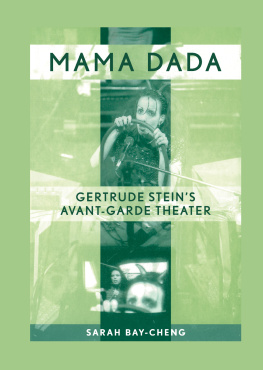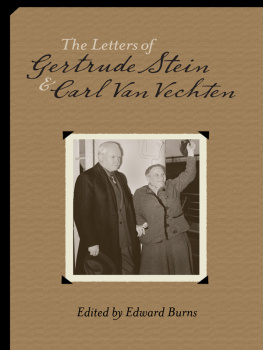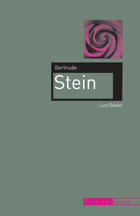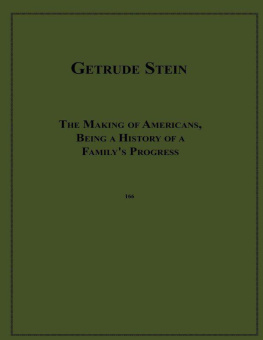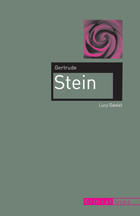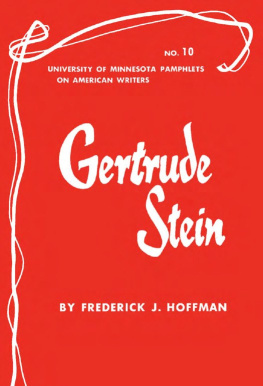
How Reading Is Written

How Reading Is Written
Astrid Lorange
A BRIEF INDEX TO GERTRUDE STEIN
Wesleyan University Press
Middletown, Connecticut
WESLEYAN UNIVERSITY PRESS
MIDDLETOWN, CT 06459
WWW.WESLEYAN.EDU/WESPRESS
2014 ASTRID LORANGE
ALL RIGHTS RESERVED
MANUFACTURED IN THE UNITED STATES OF AMERICA
DESIGNED BY QUEMADURA
TYPESET IN SCALA AND TRADE GOTHIC
WESLEYAN UNIVERSITY PRESS IS A MEMBER OF THE GREEN PRESS INITIATIVE. THE PAPER USED IN THIS BOOK MEETS THEIR MINIMUM REQUIREMENT FOR RECYCLED PAPER.
LIBRARY OF CONGRESS CATALOGING-IN-PUBLICATION DATA
LORANGE, ASTRID.
HOW READING IS WRITTEN : A BRIEF INDEX
TO GERTRUDE STEIN / ASTRID LORANGE.
PAGES CM
INCLUDES BIBLIOGRAPHICAL REFERENCES.
ISBN 978-0-8195-7511-1 (CLOTH : ALK. PAPER)
ISBN 978-0-8195-7512-8 (PBK. : ALK. PAPER)
ISBN 978-0-8195-7513-5 (EBOOK)
1. STEIN, GERTRUDE, 18741946CRITICISM AND INTERPRETATION. I. TITLE.
PS3537.T323Z698 2014
818.5209DC23
2014013666
5 4 3 2 1
FRONTISPIECE: LUKE BEESLEY, WORD. PENCIL AND PASTEL ON PAPER, COURTESY OF THE ARTIST.
ACKNOWLEDGMENTS
This book has emerged over a number of years and with the support of many people. An earlier version of the manuscript was submitted and examined for the degree of Doctor of Philosophy at the University of Technology Sydney in Australia. Thank you to Stephen Muecke, whose supervision in the first year of my project has left an indelible trace in these words and in my thought. Thank you to Martin Harrison, my supervisor throughout and a most extraordinary and generous friend and mentor. I have finished this project at the College of Fine Arts, University of New South Wales. Thank you to my new colleagues, students, and friends, for welcoming me so warmly. Thank you especially to Ross Harley, Jill Bennett, Anna Munster, and Caleb Kelly.
Thanks to everyone at Wesleyan University Press. Working with a press that I admire so much is a true thrill. Thank you to Suzanna Tamminen, Leslie Starr, Ann Brash, and Christi Stanforth for their kindness and exceptional professionalism. Thank you also to Lyn Hejinian, who made it all possible.
Thank you to the University of Pennsylvania, and in particular to the wonderful community at the Kelly Writers House. When I first visited Philadelphia in 2009, I never imagined the many ways it would change my thinking and writing. Thank you to everyone I spoke to and heard speakin the classroom, in a kitchen, on a train, off the record. Thanks in particular to Bob Perelman, Charles Bernstein, Al Filreis, and Rachel Blau DuPlessis for inviting me into their pedagogical spaces.
Early versions of this work were presented at the Whitehead Research Center at Claremont College, the Open Fields forum at Serial Space in Chippendale, the Critical Animals creative research symposium in Newcastle, the Blanket talk series in Philadelphia, ModCon at Sydney University, and the 2010 annual conference for the Society for Literature Science and the Arts. Thank you to everyone who hosted, fed, and talked to me in my travels. Thank you to the staff at the Mandeville Special Collections Library at the University of California San Diego for their assistance in my archival pursuits. Thank you also to my students and colleagues at the University of Technology Sydney and the University of Western Sydneyall the way through the writing process I was cheered along, encouraged, and nourished by classroom discussions.
Thank you to Tom Lee, Jason Childs, Elena Gomez, Kieran Daly, Trisha Low, Sam Moginie, Michael Farrell, Ella OKeefe, and Ed Hopely for reading various versions and drafts of chapters. Thank you also to my doctoral thesis examinersCharles Bernstein, Lyn Hejinian, and Lee Ann Brownfor their suggestions and encouragements. Thank you to the two anonymous reviewers who read for Wesleyan University Press and whose comments were most useful and insightful. An enormous thank-you to John Paetsch, a scholar and poet I admire, respect, and love, who kindly read the near-to-final version of the manuscript and whose suggestions, challenges, inquiries, and celebratory marginalia have finally brought this book to life.
There are many people dear to this project whom I havent yet mentioned: Gordon Faylor, Vclav Paris, Kaegan Sparks, Cecilia Corrigan, Laura Finch, J. Bret Maney, Gabriel Sessions, Jessica Cross, Lanny Jordan Jackson, Kristen Gallagher, Andrew Hao, Nathaniel Davis, Michael Halewood, Patrick Armstrong, Patrick Grant, Aden Rolfe, Stuart Cooke, Tim Wright, Kate Fagan, Peter Minter, Joel Scott, Jacquie Kasunic, Zo Sadokierski, Alastair Pennycook, Emi Otsuji, Liam Field, and Alex White. Thank you for advice, chats, wanderings, adventures, and vital oddities.
Thank you to my family for everything. Thank you to my dearest friend, Miriam Chatt, for a lifetime of love, and to Tom Lee, Tom Smith, and Nick Keys, for being alongside always. Finally, thank you to Ed Hopely, who walked into the middle of this book and with whom the future extends, brilliantly.
I dedicate this book to my mother, Patricia Magee.
WORKS BY GERTRUDE STEIN
ABT | The Autobiography of Alice B. Toklas |
ASR | A Stein Reader |
EA | Everybodys Autobiography |
GP | Geography and Plays |
GSS | Gertrude Stein Selected |
HTW | How to Write |
HWW | How Writing Is Written |
I | Ida: A Novel |
LA | Lectures in America |
LB | Lifting Belly |
LOP | Last Operas and Plays |
MA | The Making of Americans |
N | Narration |
PP | Portraits and Prayers |
TB | Tender Buttons |
W | Writings: 19321946 |
WAM | What Are Masterpieces |
The use of this is manifold. Stein TB 8
Introduction
Index
In the early stages of this project, I accidentally became a book indexer. Having no formal training, I approached the activity of indexing as a reader and researcher. I know how to use an indexindeed, I rely on indexes to follow conceptual and thematic threads across diverse texts. I have always considered the index a synthesis of two distinct inventories: on the one hand, a list that one searches for specific entries; and on the other, a list that one cruises for oddities and unanticipated connections. My own attempts to construct indexes have been with this synthetic goal in mind; I aim to write an index that functionally organizes conceptual and referential material in addition to documenting the contingencies and unexpected convergences of a text.
The concept of an index is ambiguous. An index is a paratextauxiliary and derivative. It is also a kind of translation that presents an alternative version of a books text. An indexer chooses specific concepts to act as categories, subcategories, and cross-references: these choices, implicitly, constitute editorial statements (and sometimes political propositions) via the emphasis or de-emphasis of certain relations. An index is often a readers first point of contact with a textit functions as an introduction, glossary, directory, map, or lexicon. Indexing is an inexhaustible activity; each index contains only an example of possible entries. The word index refers to various activities and occasions of pointing. As a books index points to its content, an index finger points to objects of concern or interest; so too does the index of a measuring instrument point to a reading on a scale, and the hands of a clock point to the time. The nose is an index, for it points out and away from the face, just as a singular vector points out away from a problematic and toward an approach for solution. In printing, an index is a typographical image in the shape of a gloved hand pointing. In mathematics, optics, computing, and economics, the index functions variously to denote different kinds of dependent, contextual, and indicative relations. An index is that which indicates, elicits a response, redirects gaze, diverts attention, shifts the conceptual terrain.
Next page
